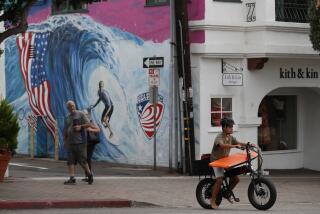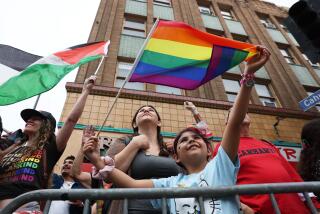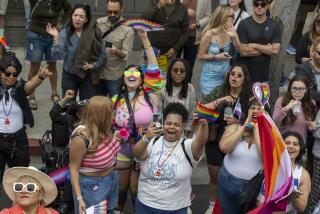Popular Mardi Gras Parade Returns to San Luis Obispo
SAN LUIS OBISPO — Residents here like to boast of “the SLO life.”
City leaders promote this pace with strict rules to ensure a small-town, wholesome quality of life. Drive-thru windows at fast-food restaurants are outlawed in the belief that they contribute to litter and air pollution.
Long before smoking was banned in offices and restaurants throughout California, it was forbidden in San Luis Obispo. And the city’s planning department requires all builders to consider front porches in an effort to promote neighborliness.
So it wasn’t much of a surprise when city officials two years ago decided to ban the increasingly rowdy Mardi Gras Parade. Organizers, however, sued the city and a Los Angeles federal judge last year ruled in their favor, saying the city had no right to prevent the parade or impede it with high fees.
The judge’s decision came too late for organizers last year, but the popular Mardi Gras Parade will be back today in downtown San Luis Obispo, which has 43,000 residents.
In the past, the parade drew as many as 35,000 people when it was held on weekend nights, and as many as 18,000 people when it was held on Fat Tuesday, the night before the start of Lent.
The parade has been moved to the afternoon this year in hopes of attracting families and discouraging the sort of roving parties that have followed past events.
“It really isn’t the parade that’s the problem,” said Capt. Dan Blanke of the San Luis Obispo Police Department.
People from outside the area have made up more than half of past arrests. In 2001, 120 people were detained for minor offenses during five days of Mardi Gras celebrations, with an additional 180 people cited for alcohol violations.
One police officer was injured in the 2000 parade, and another was injured in 2001 so badly that he was on medical leave for a full year.
Even without a parade last year, there were 60 arrests and 60 alcohol citations during the same five-day period leading up to Fat Tuesday.
Those numbers are huge by San Luis Obispo standards. Even with 27,000 students at Cal Poly San Luis Obispo and Cuesta College, it’s rare for police to arrest more than 12 people over a weekend.
“We probably have 10 officers working on a usual weekend night, but we’ll have full deployment of our 61 officers through Mardi Gras,” Blanke said, adding that they will be backed up by other departments. “We’re just worried that things could go sideways real fast.”
Police Chief Deborah Linden has warned in local television appearances that police will take a zero-tolerance approach to lawbreakers. “There won’t be any warnings issued,” she said. “People will be arrested if they break the law.”
Trouble, however, is a relative thing. Mardi Gras celebrations around the state in such places as Fresno, Monterey and San Jose turned into small riots in 2001, while Blanke acknowledges that nothing in San Luis Obispo’s past Mardi Gras celebrations ever approached a riot.
The city’s attempt to stop the parade is not the first time it has taken strong action against outdoor partying. An event called Poly Royal, the spring orientation for the campus, was essentially canceled in 1990 after a series of small-scale riots and looting of liquor stores.
While there have been smaller open house celebrations since, it was only last year that city leaders and university officials agreed to resurrect the name Poly Royal.
Mardi Gras organizers this year have solicited help from college sports teams, including 70-plus Cal Poly football players, to man barricades along the parade route to free police officers to patrol the sidewalks. In past years, police were often stuck inside the barricades.
“The bottom line is we have no control over what the crowd does,” said Carol Pimentel, co-chair of the Kouncil of Krewes, which puts on many of the festivities.
“What is acceptable elsewhere is not acceptable in San Luis Obispo. We are not trying to re-create New Orleans’ Mardi Gras.”
The San Luis Obispo festivities were started in 1979 by a couple from New Orleans, Don and Caryl Koberg.
“We were just going to have a party that first year at the house, but it ended up at a place downtown,” said Don Koberg, who is still an active participant.
“We had a two-block-long parade with one float. Of course, we didn’t bother with permits back then.”
More to Read
Sign up for Essential California
The most important California stories and recommendations in your inbox every morning.
You may occasionally receive promotional content from the Los Angeles Times.










